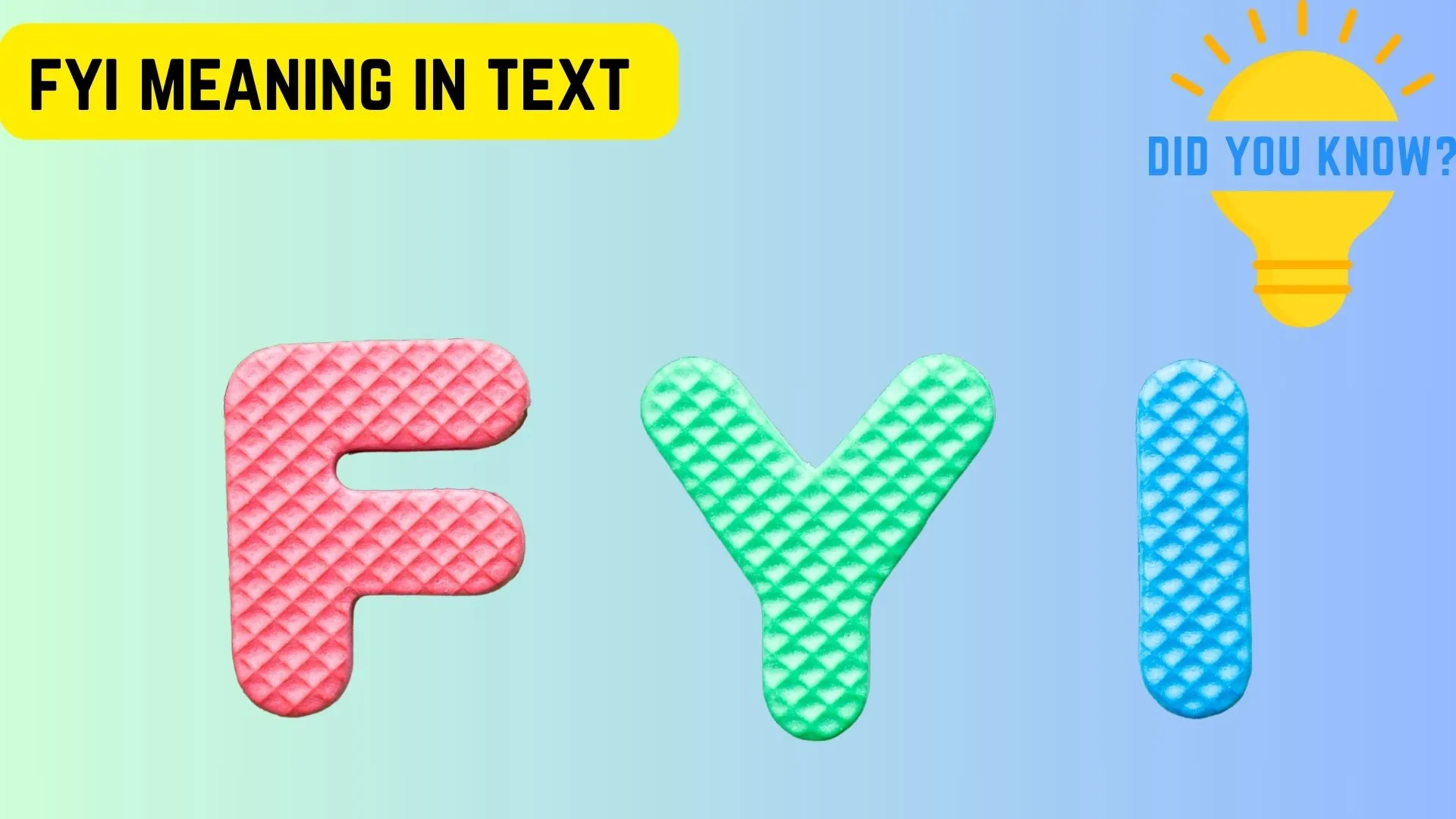In today’s fast-paced world of texting and emails, abbreviations save time and keep conversations short and clear. One of the most common abbreviations you’ll see is FYI, but what does it really mean, and how should you use it?
Whether you’re messaging a friend, emailing your boss, or replying to a group chat, understanding the correct usage of FYI can prevent confusion and even avoid unintentional rudeness.
This guide explains the FYI meaning in text, explores how it’s used in different contexts, and shares professional alternatives you can use in 2025 to sound polished and thoughtful.
By the end, you’ll not only master the abbreviation itself but also learn when it’s best to swap it out for something more formal—or more friendly.
What Does FYI Stand For in Text?
FYI stands for “For Your Information.” It’s a quick way to share details or updates that someone should know but doesn’t necessarily need to act upon.
The phrase originally came from business memos in the early 20th century, long before texting existed. Over time, it became popular in emails, instant messages, and social media. Today, it’s used globally to point out something important, relevant, or simply interesting.
How FYI Is Used in Text Messaging & Emails
FYI in Email
In professional emails, FYI often appears in the subject line or at the start of a message. It signals that the email is informational only, not requiring a reply or action. For example:
Subject: FYI: Updated Meeting Agenda.
This tells recipients they don’t need to respond but should review the details.
FYI in a Sentence
Example: FYI, the deadline has moved to Friday. Here, it acts as a quick heads-up before sharing essential details.
FYI Meaning in Hindi
In Hindi, people usually use FYI as-is, but it translates roughly to “aapki jankari ke liye” (आपकी जानकारी के लिए), meaning “for your information.”
FYI Meaning in Text From a Guy
When a guy texts “FYI,” it usually just means he’s sharing information—no hidden meaning. Example: FYI, the movie starts at 8.
FYI, Meaning From a Girl
Similarly, when a girl uses FYI, it’s typically neutral. Example: FYI, I’ll be late for dinner. Any extra meaning depends entirely on the conversation’s tone.
1. Professional Communication
In offices and professional settings, FYI is a staple for sharing updates without demanding action. Example: FYI: The quarterly report is now live on the shared drive. It keeps messages concise while ensuring everyone is informed.
2. Casual Conversations
Among friends or family, FYI can be playful or lighthearted: FYI, I grabbed the last slice of pizza. It’s a casual way to share news without expecting a response.
3. Passive-Aggressive Uses
Sometimes FYI can sound slightly sharp, especially if paired with a complaint: FYI, the dishes are still in the sink. In such cases, tone matters more than the abbreviation itself.
Is FYI Rude or Impolite?
On its own, FYI isn’t rude. However, context and tone determine how it’s received. Adding a polite phrase like “just so you know” can soften the message when dealing with sensitive topics.
Polite & Professional Alternatives to “FYI”
If you want to avoid potential misunderstandings, try these polished substitutes:
🔹 1. “Just so you know…”
Friendly and neutral, perfect for both casual and formal communication.
🔹 2. “For your reference…”
Great for emails where you’re attaching documents or links.
🔹 3. “In case it’s helpful…”
Adds a thoughtful touch, showing you care about usefulness.
🔹 4. “Thought you might like to see this…”
Ideal when sharing articles or fun updates.
🔹 5. “Just bringing this to your attention…”
Best for highlighting something important without demanding action.
🔹 6. “You might find this useful…”
A gentle way to share tips or resources.
🔹 7. “This may be of interest to you…”
Professional and polite for formal emails.
🔹 8. “A quick heads-up…”
Great for friendly or semi-formal messages.
🔹 9. “Wanted to make you aware…”
Works well when alerting someone to an issue or change.
🔹 10. “Please note…”
Perfect for formal communication and official announcements.
Advanced-Level Examples of “FYI” Alternatives in Use
- “Just so you know, the client requested a deadline extension.”
- “For your reference, I attached last quarter’s sales data.”
- “In case it’s helpful, here’s the updated project schedule.”
- “Thought you might like to see this article on AI trends.”
- “Just bringing this to your attention: the server will be down at midnight.”
- “You might find this useful: a guide to SEO in 2025.”
- “This may be of interest to you if you’re researching market growth.”
- “A quick heads-up: the elevator will be out of service today.”
- “Wanted to make you aware of the upcoming policy changes.”
- “Please note that the parking area will close at 6 PM.”
- “Just so you know, the boss is on leave tomorrow.”
- “For your reference, here’s the supplier’s contact list.”
- “In case it’s helpful, I shared the recorded webinar link.”
- “Thought you might like to see this funny meme about Mondays.”
- “Please note the new security code for after-hours entry.”
How to Choose the Best Alternative to “FYI”
- Audience matters: Use formal phrases for business and casual ones for friends.
- Tone check: Avoid passive-aggressive wording.
- Clarity first: Choose an alternative that clearly conveys whether a response is needed.
Common Mistakes When Using FYI in Text
- Overusing it in professional emails—it may feel dismissive.
- Using it in sensitive situations without context.
- Forgetting to clarify if action is required, leaving recipients unsure.
WTH Meaning in Text: What It Really Means and How to Say It Better 2025
While exploring texting slang, you’ll often see WTH, which stands for “What The Heck” (or a stronger version). Like FYI, it’s widely used, but depending on context, it can sound playful or annoyed. To soften it, try: “What’s going on?” or “Seriously?” instead.
FAQs
What does FYI mean in simple words?
It means “for your information,” used to share details without expecting action.
Is FYI formal or informal?
It works in both, but tone and context decide how it’s perceived.
Can FYI be rude?
Not inherently, but it can seem curt if the message is sensitive.
What is FYI in Hindi?
It translates to “aapki jankari ke liye” (आपकी जानकारी के लिए).
Should I use FYI in emails to my boss?
Yes, but ensure the email is purely informational and polite.
Are there better words than FYI?
Yes—phrases like “for your reference” or “just so you know” are more polished.
Does FYI need a response?
Typically no, unless the information requires follow-up action.
Conclusion
Mastering the FYI meaning in text helps you communicate efficiently and avoid misunderstandings in both casual and professional settings.
While it’s a quick and useful abbreviation, choosing polite alternatives when needed shows emotional intelligence and professionalism.
Whether you’re messaging friends or emailing clients, knowing when—and how—to use FYI ensures your words are always clear and well-received.




